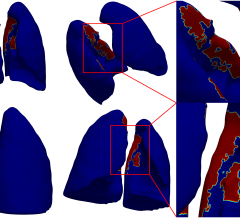
July 25, 2016 — The number of new cases of metastatic prostate cancer climbed 72 percent in the past decade from 2004 to 2013, reports a new Northwestern Medicine study. The report considers whether a recent trend of fewer men being screened may be contributing to the rise, or whether the disease has become more aggressive, or both.
The largest increase in new cases was among men 55 to 69 years old, which rose 92 percent in the past decade. This rise is particularly troubling, the authors said, because men in this age group are believed to benefit most from prostate cancer screening and early treatment.
In addition, the average prostate-specific antigen (PSA) of men who were diagnosed with metastatic prostate cancer in 2013 was 49, nearly double that for men diagnosed in 2004 with an average PSA of 25, indicating a greater extent of disease at diagnosis.
The blood level of PSA, a protein produced by cells of the prostate gland, is often elevated in men with prostate cancer.
"One hypothesis is the disease has become more aggressive, regardless of the change in screening," said senior study author Edward Schaeffer, M.D., Ph.D., chair of urology at Northwestern University Feinberg School of Medicine and Northwestern Medicine. "The other idea is since screening guidelines have become more lax, when men do get diagnosed, it's at a more advanced stage of disease. Probably both are true. We don't know for sure but this is the focus of our current work."
The paper will be published July 19 in Prostate Cancer and Prostatic Diseases, a journal from Nature.
Schaeffer's research team analyzed information from the National Cancer Data Base. It included 767,550 men from 1,089 facilities nationwide who had been diagnosed with prostate cancer between 2004 and 2013.
Over the past decade, there has been a substantial reduction in the number of men being screened for prostate cancer and an associated decline in the overall number of new cases of prostate cancer being reported.
"The fact that men in 2013 who presented with metastatic disease had much higher PSAs than similar men in 2004 hints that more aggressive disease is on the rise," Schaeffer said. "If I were a patient, I would want to be vigilant. I firmly believe that PSA screening and rectal exams save lives."
If a patient is diagnosed with localized prostate cancer that is aggressive, treatment can be curative. If men present with metastatic prostate cancer, treatments are not curative and only slow disease progression. Most patients with metastatic prostate cancer eventually die from the disease.
"There could be a significant increase in prostate cancer death rates if more people are diagnosed with metastatic disease, because treatments can only slow progression, it's not curable," Schaeffer said.
The study measured the total number of cases of metastatic prostate cancer, not the incidence, for example, of cases per 100,000. In addition, metastatic disease began rising in 2008, before the change in screening recommendations from the U.S. Preventive Services Task Force. Thus, investigators said, they can't definitively link the increased cases to reduced screening alone.
Three percent of those included in the study had metastases, which means prostate cancer cells had spread to other parts of their bodies by the time the cancer was diagnosed. The number of cases of metastatic prostate cancer in 2013 (2,890) was 72 percent greater than that in 2004 (1,685). In middle-aged men 55 to 69 years old, the number rose 92 percent from 702 new cases in 2004 to 1,345 in 2013.
"The results indicate that screening guidelines and treatment need to be refined based on individual patient risk factors and genetics," said lead author Adam Weiner, M.D., a Feinberg urology resident. "This may help prevent the growing occurrence of metastatic prostate cancer and potential deaths associated with the disease. This also can help minimize overdiagnosing and overtreating men with low-risk prostate cancer who do not need treatment."
"This will be particularly critical for population health economics in the U.S., considering the added cost of care for metastatic prostate cancer and an aging constituency whose population over the age of 65 will double to over a projected 80 million by the year 2050," Schaeffer noted.
The research was supported by National Institutes of Health grant 5U01CA196390 and the Prostate Cancer Foundation.
For more information: www.nature.com/pcan


 December 04, 2025
December 04, 2025 









